Port Louis, Lorient. July 22nd
The three weeks in Bilbao flew by with lots of meeting people and pottering onboard. The boat needed a few jobs done and all looked ok. But after a trip out with Tania's family, I found the alternator wasn't charging. I reckon it had been like that for quite a while. During the sail south from La Rochelle I had noticed the battery voltage was not high when the engine was on. Her dad is an electronics guru and he helped me source the cause of the problem to the regulator for the alternator. He then took it away, repaired it, and had it back in an hour. Phew !! That was a worry, a day before the new crew arrived.
So Ronnie and Glenis arrived on sunday and we were already looking at the forecast for the passage to La Rochelle. There was a large swell rolling in as they arrived and it was not forecast to dissipate for a few days, so they became tourists and we did the sights of Bilbao in between checking weather forecasts. In this part of the Bay of Biscay, the continental shelf is very steep. When you go 20 miles offshore the depth goes from 200 metres to 1500 metres very quickly. This steep shelf means that any swell rolling in is pushed up becoming more confused. Other than low swell, we were obviously looking at wind direction and speed. Thursday looked good with 10 knot headwinds for the afternoon becoming easterly the following day. The swell was forecast to be down to 1 metre and the sea state slight. Closer to La Rochelle, there should be less swell but maybe more wind.
So we had a final shop on thursday and set off at 4 pm local time. On getting out we found the breeze as predicted but the sea state was confused. We motored just off the wind, hoping for calmer water once we reached the deep. In the end we found the seas confused for the first 24 hours. It was very unfomfortable at times and I can honestly say it was the worst long trip of my sailing career so far. But the boat was ok, the engine plugging away as we motorsailed. We kept the engine running at low revs so that as a wave slammed into us to slow us down, we pushed through it without losing too much momentum. By lunchtime, 20 hours out, we decided to divert to Royan at the mouth of the Gironde river. We had possible northerly winds ahead so we decided to avoid those. It would also give relief to those not feeling well on board. The wind came up a bit from the southeast as we entered the edge of the military firing range and we were able to kill the engine at last and sailed for a few hours. It then eased in the afternoon before coming back up from the northwest. We were then double reefed close hauled in 15-18 knots. The yankee had to be reefed in a bit in the last few hours as we approached the coast just to keep the boat comfortable. It was 10pm as we entered the southern channel through the shallows at the wide river mouth. we had just enough light to pick out the buoys but by the time we were exiting the channel it was dark and almost impossible to see them. We crossed the main shipping channel which had lit buoys before approaching Royan. It was difficult to distinguish the harbour lights from all the lights on land. This was made worse but the fact that it was the day after Bastille and there were ferris wheels and fireworks to obscure the view. As we got closer I got my bearings as I had been into Royan before. We lowered sails and slowly motored in the dark into the shallow channel before tying up at 1100 after a 29 hour trip that I won't forget in a hurry.
The next morning we had recovered a bit and went for a walk around the town before leaving at 130 for the trip up to La Rochelle. The forecast was for force 4 east northeast winds. This would put us on a close reach as we sailed up the coast. This was the relaxing sailing we all needed after the previous trip. We had 3 hours of glorious, if slow, sailing before the wind decided to come round into the north. That meant is was on the nose so we had to motorsail for 3 hours to round the top of the Ile D'Oleron. But at least it was sunny !!! We knew we would be arriving in the dark again, but La Rochelle was easier as the buoys were lit and easy to identify. There was also a leading light to guide you in and we tide up tired again at midnight.
The next morning was bright and sunny with a forecast for lots of heat. We sailed out under the bridge to Ile De Re and had a pleasant sail between the island and the mainland before tying up in Port Bourgenay at 5.30pm. By then it was over 30 degrees so we didn't have the appetite for a long walk. We pottered onboard and did odd jobs like cleaning our salt encrusted mooring lines and adjusting winches. As the heat of the day wained we had some dinner and wine, and all the crew were back on form. Some crew had been notably absent and uncomunicative over the longer days. But the spaceship they had travelled in was well landed and tied up by now......
With another forecast for light winds we set off at 7.15am for the long 55 mile hop to L'Herbaudiere. We set the cruising chute and sailed at first, before motorsailing in the easing breeze. With the engine at low revs we cruised along at 4-5 knots until the winds died away and the seas became glassy calm in the growing heat. We arrived into L'Herbaudiere at 4pm and once we moored up and had no breeze in our faces, we noticed how hot it had become. It was reading 34 degrees inside the boat and even with all windows open, it was baking. Outside it was even worse. You just had to stroll very slowly to not exert yourself. So we didn't do any long walk around the island. We just relaxed onboard after doing some shopping before dinner in the cooler part of the evening.
The next morning we again left at 7.15am for the 42 miles spin to Port Haliguen. We had a forecast for a little more wind from the souteast (astern) going round to the south and increasing a bit later in the day. We were able to set the cruising chute on flat seas and we worked it at boat speeds of 3 to 5 knots past ships waiting to go into St Nazare and the islands of Hoedic and Houat. It was the ideal relaxing sailing conditions and all were happy and chilled onboard. We were tied up before the promised stronger winds arrived signaling a weak depression moving into the English Channel. I got the bike out and cycled to the pictoresque touristy town of Quiberon looking for fish for dinner. After a wander around I got lucky and the crew had hake and prawns as a reward for their efforts of the day.
During the evening it got cooler and overnight we had thunderstorms for a while. The morning was cloudy and noticably cooler than the 30 degrees plus we had experienced for the last two days. There was a market at the old port nearby where we picked up the makings of a paella which Glenis was coaxed into cooking that evening. We left Port Haliguen mid morning for the reliatively short hop of 25 miles around the tip of the Quiberon peninsula and northwest to Lorient. We had to motor between the rocks at the end of the peninsula and found a swell and moderate seas on the far side, generated by the depression overnight. We set sail and again left the engine on in low revs to avoid us losing momentum in the seas. Approaching Ile De Groix the seas eased and we killed the engine to sail in the south channel. We were overtaken by a Vendee Globe race boat which was impressive. Even more impressive was when the boat turned around and came back out the narrow channel as we were going in. They are real rockets and always impressive to see, especially up close under sail.
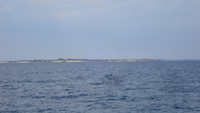
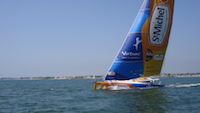
We tied up again in Port Louis and after a wander around the crew decided to stay a second night which would be Ronnie and Glenis' last night. Originally we thought of going up to the marina in Lorient itself as we had a car rented to drop them off in Roscoff for their ferry home. But they decided to stay put and get the regular ferry service in the morning to the city. That meant that we had a full day to explore. We got a ferry across the harbour to the fishing port to walk to the Cite de la Voile, the Erice Tabarly museum, dedicated to the hero of French long distance sailing. Eric designed his own boats and competed in many of the famous long distance sailing races like the Fastnet, Sydney-Hobart, Transat and set a number of speed records. He was a larger than life character who lived to sail and created many innovations in boat design which are still used by the race boats of today. The museum was created by the city of Lorient who wanted to find a use for the Uboat pens handed back to the city by the french navy in 1997. The museum is really impressive, explaining everything from yacht design, sail and rope technologies, to videos about the great man himself. I also went on a tour of the submarine base which was breathtaking. The main 2 buildings were constructed by the Germans in 9 months in 1940 with a third following a year later. The structures used a million and a half cubic metres of reinforced concerte and their 3.5 metre thick main roof was impregnable to the allied bombs. It was a great tour and showed the massive investment the Germans made in making Lorient a key part of the German war strategy during the war.
Today the whole area now houses 60 different companies with connection to the sea and sailing, employing 700 people. Everything from the construction of the superfast racing sailboats to the teams who are based there. I had the chance to wander around some of them which are berthed nearby. Now that is what is known as boatporn !!!!
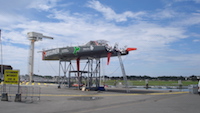
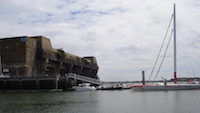
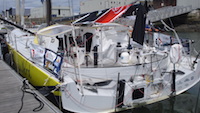
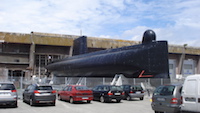
Then suddenly the trip with Ronnie and Glenis was over. The comedy duo we would like to be when we grow up were leaving for home. We had a meal out to celebrate their last night on board for now. The next day we had a car rented to drive them to Roscoff. It was the easiest way to get them there and I had a chance to drive through the green countryside on the way back. Then I just had to tidy up the boat and get it ready for the next crew of Joel and Tania who were joining me from Bilbao for a few days.